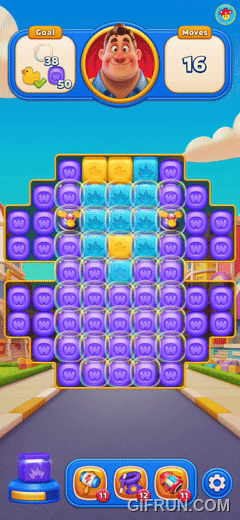
Match Villains: A Dracula-Led Heist Into the Most Brutal Market in Mobile
AnalysisHighlightsJournal 149 Ahmetcan Demirel May 27
We’ve said it before, and unfortunately it keeps getting more true with time: this is the absolute worst moment to launch a new Match-3 game.
User acquisition costs are no longer “high”, they’re absurd. The casual puzzle market, particularly Match-3, has turned into a battlefield where only the best-funded and most patient teams can survive. And even those often struggle to do so profitably. We mentioned this fact when we analyzed Dream’s wild Royal Kingdom campaign. It is the most extreme (and recent) symptom of a market pushing studios to try everything to make it work. Imagine having to cast a list that includes LeBron James, Kevin Hart, and Jimmy Fallon despite having arguably the best switcher engine in the market…
While it’ll take a long time to know whether that absurdly expensive campaign actually paid off, the fact that we need that much time to evaluate it highlights one of the core challenges in the puzzle, and especially Match-3, market. We like to think we’re building worlds, crafting mechanics, and pushing visual polish to the limit. But the cold reality is, the health of every game eventually comes down to one metric: how fast you get back the money you spent to acquire your players. In other words, your payback period.
If you’re a small startup running on fumes, forget about long payback periods. You can’t afford to play the long game. You need cash coming in fast, which means the revenue from users you acquired yesterday might literally be funding your next payroll. You’ll be optimizing for short payback periods, likely within weeks or a couple of months, which in turn forces you to frontload your monetization. The result? Players who churn before your gameplay even gets a chance to shine.
That’s exactly how Hypercasual got off the ground and exactly why it died a horrible death after the ATT changes. When UA costs went up and longer payback periods became the new normal, the model simply couldn’t keep up. The teams with money and experience pivoted to Hybridcasual. It doesn’t demand the painfully long payback periods of puzzle games, but it still requires a bit of breathing room (think 3 to 6 months, depending on your game). On the other end of the spectrum, if you’ve got the budget, the experience, and the patience to play the long game, you end up in the Match-3 market.
Puzzle games, by design, are engagement-driven. You can’t pay-to-win your way to the top like you might in strategy or RPG. Boosters and extra moves help, but they don’t guarantee a win. Your most powerful monetization lever is your EGO (end game offer), triggered every time a player fails a level. To make it work, you also need to layer in loss aversion: win streaks, win-to-progress events, anything that nudges players to avoid failure. But none of it matters if you can’t calibrate the frequency of that offer. Show it too often and players burn out. Show it too rarely and you leave money on the table by shrinking the top of your monetization funnel.
This balancing act between showing the EGO too much or too little not only delays spending but also stretches it over time. Players don’t fail consistently; the hard levels pile up gradually, which means purchases accumulate slowly, too. That’s what drives those infamous Match-3 payback periods. In some cases, you’re waiting up to two years to figure out if the $75 you spent on a user was money well spent. And of course, whether your payback period is two months or two years, the real goal kicks in after that: keeping those players around long enough to generate actual profit on top of that initial return.
In this kind of environment, launching a Match-3 isn’t just hard. It demands that you nail everything. Gameplay, visuals, monetization, retention, UA… You can’t afford a weak link. And you’d be surprised how many studios have gone under lately for betting it all on a Match-3 that didn’t stick. That’s why Match Villains from Good Job Games stands out. It’s still early, but if any new Match-3 has a shot at breaking through in today’s market, this might be the one.
Good Job Games: From Hyper to Hybrid to Heist
Let’s not forget where Good Job Games came from. Founded in 2017, the studio was a Hypercasual powerhouse. They published hit after hit during that market’s golden age and established themselves as one of the most reliable names in the space. But when ATT flipped the monetization model upside down, Good Job Games pivoted hard, and smart.
Being a Turkish studio, their transition into the casual puzzle space made sense. The local ecosystem has a strong pedigree in puzzles, and Good Job Games capitalized on that with Zen Match, one of the first true hits in the Tile Match space, which we analyzed before. After scaling the game successfully, they sold it to Moon Active, who have been running it since, though far from its previous peak.

Then came a full reset. They sold off their Hypercasual portfolio to Azur Games, putting both feet firmly in the casual puzzle camp. But their next move, Wonder Blast, didn’t land. The game was genuinely solid (and even innovative), especially in a Blast market that’s been creatively stuck for years. We talked about this before when deconstructing Time Blast, another title that tried to break the mold and paid the price.
Despite multiple iterations and some major overhauls (including a full reset like Royal Kingdom), the team eventually pulled the plug. Last we heard, it was sold to Fugo Games, a fellow Turkish studio better known for their word puzzles, but that’s a story for another day.
Then they raised $23 million. Suddenly, they had time. They had cash. And they had a clean slate. So they went after what many consider the final boss of mobile gaming: a successful, profitable, original Match-3. Enter: Match Villains.
From Flatline to Hockey Stick: A Tale of Two Launches
Comparing Wonder Blast’s first-year performance to Match Villains’ tells you everything you need to know about why Good Job Games dropped everything to focus on their new title. Wonder Blast started slow and stayed there. It had a few short-lived spikes in downloads further down the road, but none of them stuck. Each peak was followed by a quiet slide back to baseline, until there was nothing left to build on. It didn’t crash so much as bleed out. A slow, quiet death by a thousand cuts… Now it sits in limbo, waiting for a potential second life under a new developer.

Match Villains, on the other hand, has been the kind of hockey stick growth story everyone’s been chasing. It started quietly, flying under the radar for a while. But since last Christmas, it’s shown serious traction. Enough to grab the attention of anyone keeping an eye on the casual puzzle space. And it’s not just downloads trending up. Revenue is climbing right alongside, which is a much rarer and more important signal this early on.
Of course, Match Villains is still a long way from standing shoulder to shoulder with the giants of the Match-3 space, but the pace at which its revenue is growing is hard to ignore. Although it’s too early to make any bold claims about its long-term place in the genre, the early signals are strong. And honestly, given the quality of the game, none of this should come as a surprise.
A Dracula, a Propeller, and the Best-Looking Match-3 in a While
Speaking of high-quality games, it’s been 2 years since we discussed Makeover Match by Tactile, calling it an absolute standout. The moment-to-moment gameplay felt genuinely great and, refreshingly, it wasn’t just another Royal Match clone. In my very unscientific sample size of one, the level design actually felt better than that of Royal Match. I consistently hit those sweet spots of near misses and close wins. The kind of pacing that keeps you hooked without feeling manipulated.
Makeover Match still holds the crown for best level design in my book, but when it comes to core gameplay, I’ve got a new favorite. Match Villains feels like a genuine breath of fresh air in a market drowning in Royal Match clones. Its heist theme isn’t just a marketing skin. It runs through everything, from the main menu backgrounds to the obstacles in its special levels. And that theme is paired with a charmingly gothic, Transylvania-style cast, led by none other than Count Dracula himself. Well, they don’t call him that, but all he lacks is a pair of sharp teeth.

Visually, Match Villains is a treat. From the smallest particles to the flashiest animations, the polish is undeniable. Even a quick glance at the levels gives you that immediate sense of care and craftsmanship. It just looks right. With the level items, however, they played it safe, steering clear of heavy thematic visuals, which honestly makes sense. Too much stylization often backfires, and the Match-3 graveyard is full of games that overdid it and paid the price.
Special items, though, that’s where things start to stand out. The in-game boosters you can choose to use inside levels don’t reinvent the mechanics, but they look and feel fresh. There’s a sense of fun baked into their design that makes them feel original, even if their core function is familiar.
And then there’s the propeller, or rather, the propeller. The propeller booster in Match Villains is one of the most unique takes I’ve seen in terms of how it looks, feels, and plays. Bit of context here: Wonder Blast also had a propeller originally as a Blast game, and let’s just say it didn’t bring much luck. Every Blast game that used a propeller so far seems cursed. Then again, the ones that didn’t use it also flopped, but that’s a discussion for another time.
Clearly, the team at Good Job Games wasn’t ready to let the propeller go. In fact, they doubled down, making it a central piece of Match Villains, not just in gameplay but also in how the game presents itself visually. We’ll get into how it ties into core mechanics and early features shortly, but even before that, its visual presence is hard to miss.

First off, the propeller in Match Villains doesn’t look anything like the standard version we’ve seen in other games. While playing, I actually jotted down a note: “These look a lot like the Golden Snitch from Harry Potter”. Turns out, that wasn’t just me. They literally call it a Snitch! And not just one kind. There’s the regular Snitch, and then there’s the Lucky Snitch, a gleaming golden version that feels straight out of Hogwarts. So yes, you can quite literally collect golden snitches while playing Match Villains. I’d imagine the Harry Potter: Puzzles & Spells team watches this with a mix of admiration and envy.
The way the propeller, sorry, Snitch, is animated is genuinely brilliant. It almost feels alive. Most propeller animations are pretty straightforward: they fly in a straight line, maybe change direction if the board shifts, and that’s about it. Only top-tier implementations, like Royal Match, bother to make them respond dynamically. Match Villains goes a step further with a subtle but clever trick in its Snitch animation that makes it feel like it has a mind of its own.
Even when nothing changes on the board and the Snitch has a clear target, its animation always plays out in three deliberate steps. First, it ascends dramatically, covering a big chunk of the screen and immediately pulling your focus. Then, it suddenly veers off course for a split second, with no real reason. That little detour is the magic. It feels like the Snitch second-guessed itself, like it almost changed its mind. Finally, it corrects course and darts toward its actual target. It’s a tiny flourish, but it gives the Snitch a sense of intention; like it’s alive and reacting, not just following a path.


That little moment, the mid-flight zigzag that serves no mechanical purpose, is, in my opinion, a brilliant touch. It gives the booster a sense of life, as if it’s thinking, hesitating, reacting. Even when there’s no ambiguity about its target, that split-second detour makes it feel like the game is looking out for you. It adds just enough unpredictability to make each activation feel personal. Definitely a small detail, but a huge payoff for the moment-to-moment experience.
In terms of look and feel, Match Villains is, in my view, genuinely unmatched. The visual polish speaks volumes about the level of care and effort the team put into the game. Every detail feels intentional. When we talk about rising player expectations and how “every new game has to be perfect”, this is exactly what we mean. Just getting Match Villains to soft launch clearly required an enormous amount of work. And that alone should be a wake-up call for any team considering a shot at the Match-3 space. Whatever expectations you had going in, you’d better multiply them several times over. Otherwise, you’re probably setting yourself up to fail before you’ve even launched.
Quick Moves, Big Stakes, and a Lot of Snitches
In addition to this stunning visual experience, the core gameplay is exactly what you’d want from a modern Match-3: fast, dynamic, and relentlessly polished. Animations are quick and snappy, but still land with impact. Every move feels deliberate, and the visual quality carries through even at high speed. Then, as mentioned earlier, the Snitch enters the picture. And that’s when things start to really click.
The game wastes no time showing how important Snitches are, especially once it introduces the Lucky Snitch. Visually, it’s a golden-skinned version of the regular Snitch, but what sets it apart is its unpredictability and impact. There’s no clear pattern to when it appears. Every so often, a Snitch spawns with a bold “Lucky!” flash, letting the player know they just hit something special. Mechanically, the Lucky Snitch doubles the output, spawning double the amount of Snitches when triggered. It’s a clever risk-reward layer, and quite reminiscent of the Super Light Ball in Royal Match, which we’ve broken down before.

It’s a bold move from a level design perspective, especially when it comes to managing the level funnel. In tight, move-limited levels, the difference between getting a regular Snitch and a Lucky one can swing the outcome completely. That kind of variance introduces a luck factor that could unintentionally distort difficulty tuning, particularly on harder levels. Sure, the spawn rate can likely be fine-tuned over time, but doing that effectively in the early stages of a game’s lifecycle is a real challenge.
Still, it’s a gutsy addition that might just prompt the Match-3 incumbents to take a closer look at their own systems, because it really does add something meaningful to the gameplay. It introduces just enough randomness to keep things interesting, while still giving players more strategic depth. That balance is hard to strike, and Match Villains seems to pull it off. Suddenly, when you’re low on moves, taking a shot at creating a Snitch isn’t just another option, it becomes a high-stakes play. That shift adds real tension to the end of a level and makes that moment feel way more alive.
The game also introduces some genuinely original, theme-appropriate obstacles that highlight just how inventive Good Job Games has been there. There are lasers (straight out of a heist movie) that destroy boosters if they drop through their beam. And there are security cameras that lock boosters in place, putting them in a cage if they aren’t used within two moves.
Clearly, these mechanics are designed to push players to use their boosters more actively, adding urgency and tempo to the gameplay. As someone who likes to plan ahead, I’ll admit it’s a little frustrating not being able to wait for my Snitch and Bomb to land side-by-side for a perfect combo. But even I can see how these obstacles keep the game dynamic and the pacing tight for a broader audience.

The metagame, on the other hand, largely sticks to the market playbook. It follows the Toon Blast-style structure, where players progress through chapters simply by beating levels. No renovation tasks, no narrative gates. Each chapter comes with its own visual theme, reflected as a background image in the main menu, giving the progression a bit of personality without adding complexity.
But it’s in the chapter transitions where the game starts to show its personality again. Each new chapter kicks off with a short cinematic. Usually featuring the main characters pulling off a heist or making a dramatic escape from the cops. It’s a small touch, but it reinforces the heist theme in a way that feels consistent and deliberate. On top of that, the special levels are branded as “Big Heists”, complete with their own custom obstacle that fits naturally within the world. It’s another example of how Match Villains manages to blend familiar structures with thematic flair.

Finally, one small but interesting detail is how the game introduces new events. Instead of the usual pop-ups or banners, it uses a social media-style interface. Something that feels straight out of Instagram or Snapchat. It’s a subtle shift, but it gives the game a fresh, modern feel that stands out in a space where most games still rely on the same old UI patterns.
All in all, Match Villains seems to have struck a solid balance between innovation and proven market fundamentals. It doesn’t come off as just another Royal Match clone, but it also doesn’t try to reinvent the wheel for the sake of it. It follows some well-established rules, and that’s part of what makes it work. Give it some time, though, and you start to see where it really sets itself apart from the rest of the market.
Too Early to Call, Too Good to Ignore
As we said at the top, calling a Match-3 a “hit” takes time. A lot of time. Just look at Royal Kingdom, launched more than two years ago and still deep in the trenches trying to get over the hump. So no, it’s far too early to declare Match Villains a breakout success. But that doesn’t mean we can’t read the tea leaves. And right now, they’re looking pretty damn compelling.
The gameplay walks a smart line between fresh mechanics and proven design. The visual quality is top-tier. And if you spend even a little time with it, you’ll notice mechanics and polish that go beyond the usual template. Add to that a set of early revenue numbers that already put it on the radar, and it’s clear this isn’t just another flash-in-the-pan launch.
Combine that with Good Job Games’ hard-earned experience in both hits and misses and a sizable war chest from recent deals, and you’ve got a studio that’s unusually well-positioned to actually climb the mountain ahead.
It’s still a long road. The space is brutally competitive. But for the first time in a while, I’m genuinely bullish on a new Match-3. And I don’t say that lightly, especially after everything we’ve covered about how brutal this market has become. Match Villains has a real shot. And if it makes it, the ripple effects across the market could be significant. It’s definitely going to be interesting to watch how this game grows…







